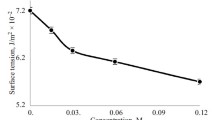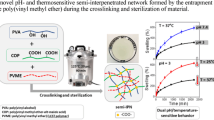Abstract
Three types of poly(vinyl alcohol) were cross-linked by glutaraldehyde to form water-swellable materials possessing a three-dimensional, molecular network. Proxyphylline and theophylline were incorporated into the polymer networks during the cross-linking reaction. The firm hydrogels formed were dried and reduced to a particle size of 400–630 µm. The molecular structure of the gels was characterized by equilibrium swelling measurements which allowed the determination of the average distance between two cross-links and, hence, the macromolecular mesh size. The sulfate and glutaraldehyde residues contained in the purified and nonpurified cross-linked polymers were analyzed, and methods for their elimination and inactivation were developed. Drug release from the highly cross-linked gels could be controlled over more than 12 hr, as the diffusion process in these very dense macromolecular networks is rather slow. The extent of branching and entanglement of the polymeric chains appeared to have an important effect. In addition, the release rate was influenced greatly by the amount and, to a lesser extent, by the type of drug in the network.
Similar content being viewed by others
REFERENCES
B. Gander. Ph.D. thesis No. 2187, School of Pharmacy, University of Geneva, Geneva, 1986.
N. A. Peppas and B. D. Bar-Howell. In N. A. Peppas (ed.), Hydrogels in Medicine and Pharmacy, CRC Press, Boca Raton, Fla., 1986, Vol. 1, pp. 27–56.
H. Yasuda, L. D. Ikenberry, and C. E. Lamaze. Makromol. Chem. 125:108–118 (1969).
S. J. Wisniewski, D. E. Gregonis, S. W. Kim, and J. D. Andrade. In J. D. Andrade (ed.), Hydrogels for Medical and Related Applications, ACS Symposium Series 31, ACS, Washington, D.C., 1976, pp. 80–87.
B. K. Davis. Proc. Natl. Acad. Sci. USA 71:3120–3123 (1974).
H. S. Koo and M. S. Jhon. Bull. Korean Chem. Soc. 1:138–143 (1980).
J. M. Wood, D. Attwood, and J. H. Collett. Drug Dev. Ind. Pharm. 9:93–101 (1983).
C. T. Reinhart and N. A. Peppas. J. Membr. Sci. 18:227–239 (1984).
N. A. Peppas and C. T. Reinhart. J. Membr. Sci. 15:275–287 (1983).
W. R. Good. In R. Kostelnik (ed.), Polymeric Delivery Systems, Gordon and Breach, New York, 1976, pp. 139–156.
H. B. Hopfenberg, A. Apicella, and D. E. Saleeby. J. Membr. Sci. 8:273–282 (1981).
S. Gaeta, A. Apicella, and H. B. Hopfenberg. J. Membr. Sci. 12:195–205 (1982).
R. W. Korsmeyer and N. A. Peppas. J. Membr. Sci. 9:211–227 (1981).
N. A. Peppas and N. M. Franson. J. Polym. Sci. Polym. Phys. Ed. 21:983–997 (1983).
R. W. Korsmeyer and N. A. Peppas. J. Contr. Rel. 1:89–98 (1984).
P. I. Lee. Proc. Int. Symp. Contr. Rel. Bioact. Mater. 9:54–60 (1982).
P. I. Lee. Polym. Comm. 24:45–47 (1983).
C. C. R. Robert, P. A. Buri, and N. A. Peppas. J. Contr. Rel. 5:151–157 (1987).
N. A. Peppas. In J. M. Anderson and S. W. Kim (eds.), Recent Advances in Drug Delivery Systems, Plenum Press, New York, 1984, pp. 279–289.
B. Gander, R. Gurny, and E. Doelker. Pharm. Acta Helv. 61:178–184 (1986).
B. Gander, R. Gurny, E. Doelker, and N. A. Peppas. J. Contr. Rel. 5:271–283 (1988).
J. C. Bray and E. W. Merrill. J. Appl. Polym. Sci. 17:3779–3794 (1973).
N. A. Peppas and E. W. Merrill. J. Polym. Sci. Polym. Chem. Ed. 14:459–464 (1976).
B. Kakac and Z. J. Veidelek. Handbuch der photometrischen Analyse organischer Verbindungen, Verlag Chemie, Weinheim, GDR, 1974, Vol. 1, p. 219.
P. L. Ritger and N. A. Peppas. J. Contr. Rel. 5:23–36 (1987).
P. L. Ritger and N. A. Peppas. J. Contr. Rel. 5:37–42 (1987).
R. W. Baker and H. K. Lonsdale. In A. C. Tanquary and R. E. Lacey (eds.), Controlled Release of Biologically Active Agents, Plenum Press, New York, 1974, pp. 15–71.
N. A. Peppas and S. R. Lustig. Ann. N.Y. Acad. Sci. 446:26–41 (1985).
C. Robert, N. A. Peppas, and P. Buri. Proc. Int. Symp. Contr. Rel. Bioact. Mater. 12:130–131 (1985).
Author information
Authors and Affiliations
Rights and permissions
About this article
Cite this article
Gander, B., Gurny, R., Doelker, E. et al. Effect of Polymeric Network Structure on Drug Release from Cross-Linked Poly(Vinyl Alcohol) Micromatrices. Pharm Res 6, 578–584 (1989). https://doi.org/10.1023/A:1015949330425
Issue Date:
DOI: https://doi.org/10.1023/A:1015949330425




